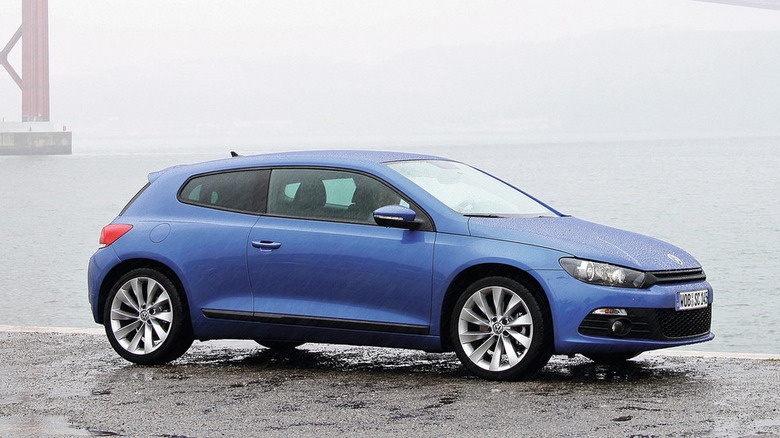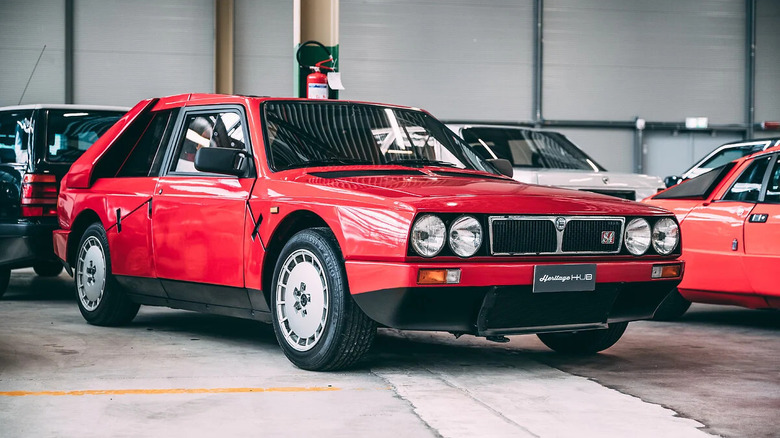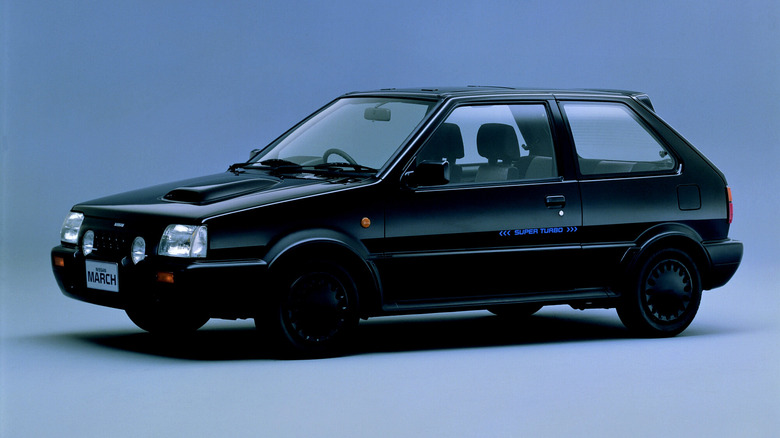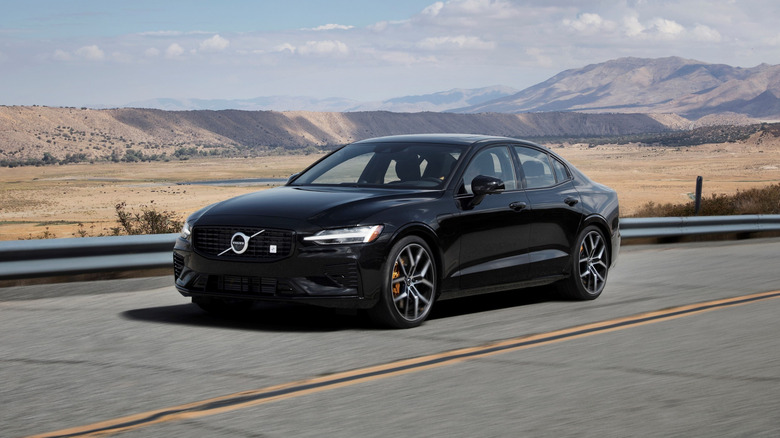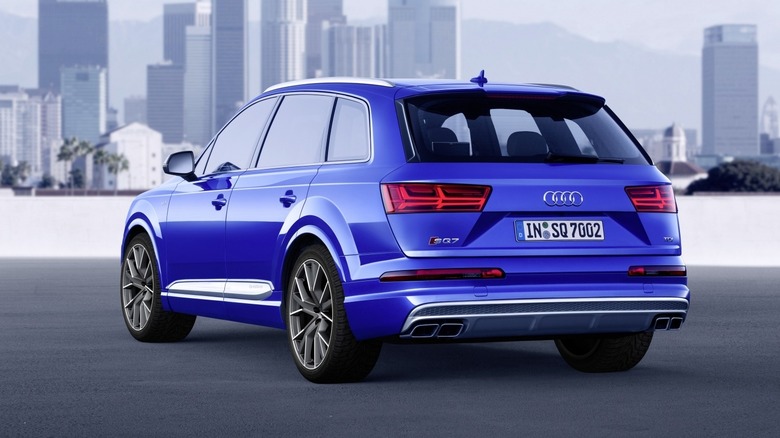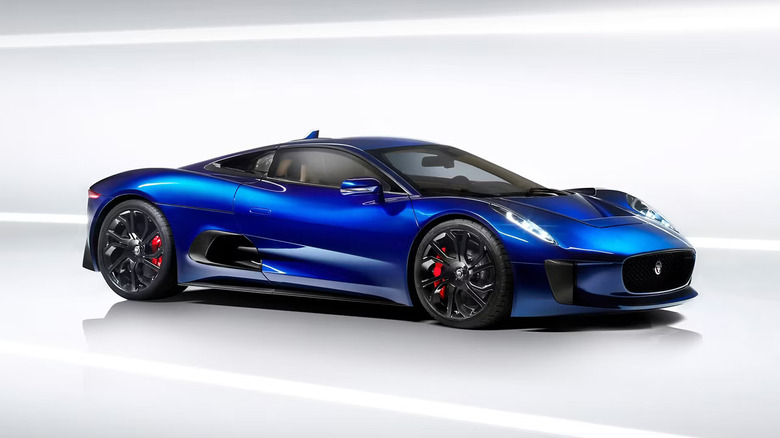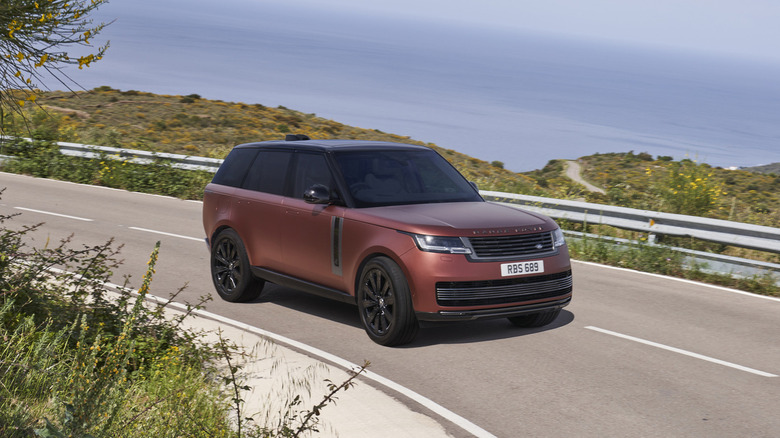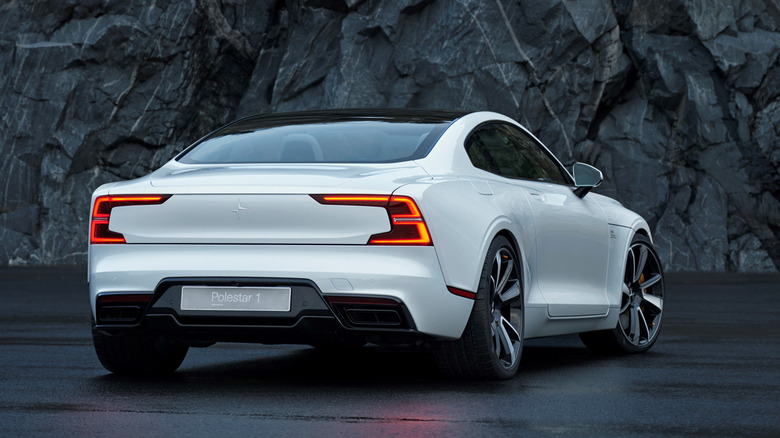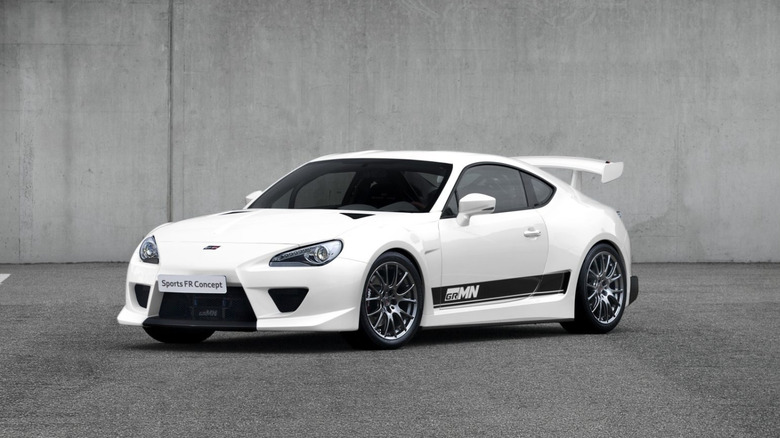10 Of The Coolest Cars Ever Equipped With Twin-Charged Engines
Superchargers and turbochargers are nothing new in the automotive industry. Superchargers on car engines date to at least 1896 when Rudolf Diesel filed a patent for using one with his eponymous engine type, though the history of this system goes back further. Likewise, the turbocharger has a deeper history, but Oldsmobile is often credited with the first mass-produced turbocharged car in the 1962 F85 Jetfire V8 coupe.
Since then, automotive engines featuring forced induction have mostly stuck with one or the other, depending on the design brief. Superchargers are desirable for delivering a compressed charge of air low in the engine speed range as they have historically been belt-driven and spool up in concert with the crankshaft. Turbochargers, on the other hand, generate boost pressure from the flow of exhaust gases, meaning they are better suited for delivering big power further up in the engine's operating range.
Modern car engines employ various techniques to combat this inherent lag in the system. But really, one of the best ways to eliminate turbo lag while delivering a constant flow of forced induction punch is to blend a turbo with a supercharger. Otherwise known as a twin-charged engine, this approach generally features a supercharger for creating boost at low RPMs with a turbocharger that kicks in at higher RPMs. It is necessarily complicated, so can be a tough business case for mass production. However, there have been some pretty interesting applications of the twin-charged engine over the years and we've collected 10 of the coolest for your perusing pleasure.
Lancia Delta S4 Stradale
Born during the wild era of Group B racing that briefly stole the stage in the 1980s, Lancia's Delta S4 Stradale was a lightly disguised rally car. Technically a homologation special, it was a road-legal version of the 490-horsepower all-wheel drive screamer going up against the best from Peugeot, Fiat, Ford, and Audi in pursuit of the Group B crown. And like the actual racer, the S4 Stradale came with a twin-charged engine.
Starting with a 1,759 cc 16-valve inline-four, Lancia strapped on a supercharger and a turbocharger along with a pair of intercoolers to produce an estimated 250 horsepower. Drivers note that the switch from the supercharger boost to the turbo is very obvious at around 4,000 RPM. At the time, turbocharging was popular for its ability to generate big power numbers, but the Abarth racing division was fond of how superchargers did their thing at low RPM.
And so, the first production twin-charged car was born, albeit in very low volumes. Rules stated that at least 200 of the Delta S4 Stradale were to be made to meet homologation requirements, but prohibitive costs and limited commercial appeal resulted in a total run of less than 80, though details are murky. Featuring a tubular space frame chassis and carbon-Kevlar bodywork just like the rally car, these unusual Lancias paved the way for future twin-charged engine innovation.
Zenvo ST1
One of the more recent examples of a twin-charged engine comes from Denmark's ultra-expensive hypercar manufacturer Zenvo. Debuting in 2009 at the 24 Hours of Le Mans Driver's Parade, the ST1 name is short for Supercharged Turbocharged 1. Wild design with a gaping front maw and carbon composite body panels finished in all manner of eye-searing finishes is no match for what's mounted out back. It begins with a Corvette Z06-sourced 7.0L LS7 V8 and ends with 1,104 horsepower at 6,900 RPM and 1,055 lb-ft of torque at 4,500 RPM.
To get there, Zenvo fits an in-house designed forged crankshaft that destrokes the mill to 6.8 liters, followed by the fitment of a supercharger and turbocharger. The intent was for a track worthy car that could be used comfortably on the street. As a result, the ST1 is done up with a leather and Alcantara-trimmed cabin featuring automatic climate control and navigation. But when all that boosted output is uncorked on the circuit, the ST1 is ready with a purpose-built chassis.
Highlights include a four-corner double-wishbone suspension, adjustable dampers and anti-roll bars, a Torsen limited-slip differential, and 15" Brembo brakes with six-piston calipers all around. Zenvo only planned to build 15 of these twin-charged cars and just three examples were slated for delivery to the U.S. With a price tag around $1.8 million, the ST1 is also the priciest twin-charged car on our list.
Nissan March Super Turbo
The Nissan March, or Micra in non-Japanese markets, is a relatively unexciting compact car that has been in continuous production since the early 1980s. Millions of these little Nissans have been sold over five generations, and the older ones are sometimes described as unexceptional classic cars. However, it should be noted that the early models featured styling from Italdesign's famous Giorgetto Giugiaro, and that towards the end of first-gen production, there was a special run of Marches that were anything but unexceptional.
Dubbed the March Super Turbo, these little coupes were built to satisfy homologation rules for Nissan's March Little Dynamite Cup Race series. The Super Turbo road car had a 930 cc version of the MA09ERT inline-four engine that was small enough to meet racing class regulations with the 1.4 turbo coefficient applied. With a supercharger and turbocharger mounted, this wee engine only made 108 hp and 96 lb-ft of torque, but with a 1,698-pound curb weight, they were likely fun to drive.
This engine, the only commercially available twin-charged unit in Japan at the time, ran on 10 psi of supercharger boost up to about 4,000 rpm. From there, the turbocharger kicked in with 14 psi of boost up to the 6,500-rpm redline. A trick feature was the magnetic clutch that remained decoupled from the supercharger at around-town speed to keep efficiency high, only activating the blower with a hard punch of the throttle.
Volkswagen Scirocco
Volkswagen built the Scirocco over three generations and it is the final one we're after today. Never sold Stateside, this GTI-based mini shooting brake that spawned underrated variants like the Scirocco R, arrived in 2008 with four powertrain options. One of those was the 1.4L TSI Twincharger, an engine that won the International Engine of the Year award the following year and saw duty in a host of VW products, including the Golf, Eos, and Seat Ibiza Cupra.
Making 158 hp at 5,900 RPM and 177 lb-ft of torque from 1,750 to 4,500 RPM, the 1.4 TSI inline-four had a relatively high specific output of 113 hp/liter. Getting there involves a belt-driven Roots-type supercharger that is actuated at low engine speeds by a magnetic clutch integrated within the water pump. As the engine starts rotating faster, a control flap keeps fresh intake air flowing, based on the specific operating point, to the supercharger and turbocharger as they are working in series at this point.
At 3,500 rpm, the supercharger goes offline, the turbo takes on all the forced induction work, and that control flap is wide open. It's an interesting twin-charging approach that seeks to eliminate turbo lag across the power band, while keeping output strong at the same time. Based on a Motor Trend review that said, "the engine feels like it has a perfect flat plateau of torque from 2,000 rpm until redline", it would appear Volkswagen did the twin-charged engine right.
Volvo S60 Polestar Engineered
Before Polestar became an all-EV offshoot of Volvo, it was the Swedish automaker's in-house speed skunkworks, much like Mercedes AMG or BMW M. One of the last Volvos to see the Polestar treatment was the 2019 S60 mid-size sedan, and it was a twin-charged doozy. Not only did the 2.0L inline-four engine receive dual forced induction in the form of a turbocharger and supercharger, it was also a plug-in hybrid with a pair of battery-powered electric motors spinning the rear wheels.
With all components in this wildly complex powertrain running at full bore, the hotrod S60 was good for 415 hp and 494 lb-ft of torque. A neat aspect of this setup was that you could drive for about 21 miles in silent EV mode before unleashing the twin-charged combustion mill. Unfortunately, Volvo only built 20 of these surefire future collectibles and they were sold in just 39 minutes, so seeing an example in the wild is a rarity.
And doing so requires eagle eyes as these Polestar Engineered sleds followed the classic European sleeper formula of subtlety. The only visual giveaways are small, square white badges on the front grille and trunk, unique 19" wheels, gold-finished brake calipers, and matching seat belts. Were you to crawl underneath, you might spot the gold-trimmed Öhlins dampers, a high-end touch helping keep these coolest of twin-charged Volvos planted during sub-5-second 0-60 runs.
Audi SQ7 TDI
While Volvo may have one of the most complicated twin-charged engines in a modern production car, Audi could lay claim to the most exciting in the SQ7 TDI as it blends a triple-charged forced induction system with a diesel-powered 4.0L V8. Used to power some of the fastest diesel-powered cars ever made, Car and Driver called it "...the most advanced compression-ignition engine ever fitted to a road-legal car," and a look at the specifications makes it easy to see why.
Power generation starts with a 48-volt electrical system feeding a small electric motor that can spin the intake tract-integrated supercharger up to 70,000 RPMs in just a quarter of a second. As power demand builds, the first of two turbochargers starts spooling up, with the second coming online above 2,200 RPM. This twin-turbo setup is fed by a split exhaust utilizing Audi's Valvelift System. With it, each variable geometry turbo receives exhaust gas from one of the exhaust valves of each cylinder. When it's time to activate the second turbo, a sleeve moves the camshaft to activate that valve. Very fancy.
This incredibly complex mechanical dance translates to 429 hp and 664 lb-ft of torque, the latter of which is on tap as low as 1,250 RPM. The 4.8-second sprint to 62 is impressive for an SUV of this dimension and reining it all in is an adaptive air suspension, variable ratio steering, plus options like 16.5" carbon ceramic brake rotors, electro-mechanical active roll stabilization, and four-wheel steering. The very definition of a cool twin-charged vehicle.
Jaguar C-X75
Had Jaguar followed through on its plan to build 250 examples of the C-X75 in 2010, this twin-charged hypercar could have gone down in history as perhaps one of the best. Certainly, as a concept car it was way ahead of its time. Developed in the same timeframe as greats like the McLaren P1 and Porsche 918 Spyder, the C-X75 had the on-paper stuff needed to compete. Namely its high-strung, electrified twin-charged engine. The ICE system consisted of an F1-inspired 1.6L inline-four strapped with a supercharger and turbocharger.
Built with help from Williams Advanced Engineering, this small four-cylinder engine made 500 horsepower on its own. The supercharger provided boost up to 5,500 RPM, at which point the turbocharger kicked in and cranked up all the way to a 10,200-RPM redline. Factor in the dual battery-powered electric motors good for 200 hp and 300 lb-ft of torque each, and total system output came in at 850 horsepower and 737 lb-ft of torque.
Jaguar said it was the world's highest specific output engine at the time and it was nestled within the company's first carbon fiber monocoque. Performance highlights include going from 0 to 100 mph in under 6 seconds, a clocked speed of 200 mph, and a theoretical top speed of 220 mph. Plus, you could drive it around on battery power alone for 37 miles. Unfortunately, Jaguar pulled the plug after building at least seven C-X75s for the Bond film "Spectre" due to a vague concern with the global economic climate.
Land Rover Range Rover
If you're willing to sacrifice the sound of a big V8 in your big, fancy current-generation Range Rover, Land Rover offers a rather impressive twin-charged engine as an option. Called the P400, it is a DOHC 3.0L inline-six that makes a potent 395 hp at 6,500 RPM and 406 lb-ft of torque at 2,000 RPM. Like every twin-charged engine here, the P400 works with a supercharger and a turbocharger.
The supercharger can spin up to 65,000 RPMs in half a second courtesy of a 48-volt-powered motor, much like the method employed by Audi for its SQ7 TDI. But a single twin-scroll turbocharger is at work in the Range Rover. It's fed by an exhaust manifold that is split in two, one side each for three of the engine's six cylinders. This separate flow creates greater spacing between exhaust pulses for improved driveability at lower RPM says Land Rover.
It works in concert with the automaker's Continuous Variable Valve Lift tech that reduces engine pumping losses by electro-hydraulically varying the inlet valve timing and lift profile. Factor in the Variable Cam Timing, on both the intake and exhaust camshafts, and it becomes clear that Land Rover was taking the twin-charged design intent of eliminating turbo lag seriously with these engines.
Polestar 1
The first car built by Polestar after it split off from Volvo was the simply named 1, a disruptive performance EV. With carbon fiber bodywork draped over a Volvo S90 platform shortened by 8 inches between the wheels and behind the rear-end, the Polestar 1 was designed to echo Volvo's vintage P1800 coupe. But the high-tech 2.0L twin-charged four-cylinder plug-in hybrid powertrain was as modern as they come. It was based on the engine found in the XC90 T8, which was used to spin the 1's front wheels.
A supercharger provides the compressed intake charge until the engine hits 3,500 RPM, at which point the turbo takes over. Around back, a pair of battery-powered electric motors drive the rear wheels with individual planetary gearsets for torque vectoring capability. Between the 232 hp from these motors, the 68-horse electric motor used to spin the ICE crankshaft at startup, and that gas-powered mill's juice, combined Polestar 1 output measures 609 hp and 738 lb-ft of torque.
It'll sling to 62 mph in 4.2 seconds, it can drive on battery power alone for 77 miles, and only 1,500 were ever made available for sale. With a six-figure price point, the Polestar 1 had an equally limited audience, but its looks alone qualify this unique Polestar for cool car status. Add in the Akebono brakes, manually adjustable dampers, and distinctly Swedish understated vibe, and you have arguably one of the coolest twin-charged cars ever made.
Toyota GRMN Sports FR Concept
GRMN is short for Gazoo Racing Meister of Nürburgring, a vehicle moniker that is as awesome as they come. Almost as awesome as the twin-charged engine powering this fanciful take on the Scion FR-S, predecessor to today's Toyota GR86. Forever dinged as not making enough power, these classic sports cars made 200 hp from a naturally aspirated 2.0L boxer four cylinder. So, to silence the critics, Toyota and its in-house tuning division Gazoo Racing built the Sports FR Concept.
Debuting at the 2012 Goodwood Festival of Speed, the twin-charged engine in this concept was making an extra 115 horsepower for 315 total and torque was more than doubled from a stock 151 lb-ft to 311. Beefier tires, measuring 245/40 front and 265/35 rear, were mounted on special lightweight wheels. The suspension was tuned by Gazoo Racing for the track, a dual exhaust system was fitted, and a unique aerodynamic body kit was installed.
The updates continued inside with specially developed bucket seats, a roll cage, four-point safety harnesses, and crucially, a boost gauge. Toyota never did a production run of the GRMM Sports FR Concept due to how the added costs detracted from the base car's inherent affordability and the fact that the transmission could not handle all the extra power. However, it remains a very cool showpiece of what a twin-charged engine can be.
